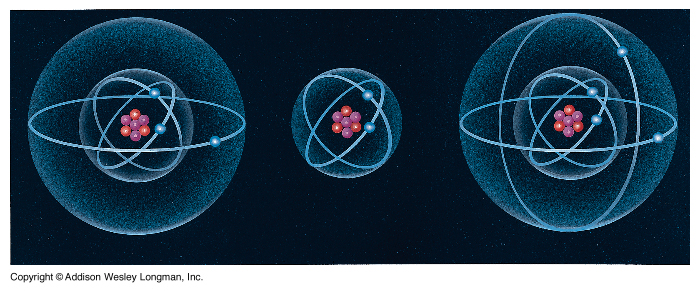 charge is the opposite. Understanding
electric charges will help us to understand the electric
field.
charge is the opposite. Understanding
electric charges will help us to understand the electric
field. Electricity
One of
the first steps to understanding electromagnetism
is by understanding electric charges and the electric field. Put simply, an
object can have one of three electrical properties. It can be: neutral
(no net charge), positive or negative. A positive object
possesses exactly that, a net positive charge. A negative charge is the opposite. Understanding
electric charges will help us to understand the electric
field.
charge is the opposite. Understanding
electric charges will help us to understand the electric
field.
Every
object is composed of atoms.
Atoms, generally, have both positive and negative
charges. Electrons
possess a negative charge and hold the power of transforming
an object back and forth between the three electrical
properties. If an
object has a surplus of electrons it is negatively charged, if
an object has a deficit of electrons it is positively charged,
and if an object has neither a deficit nor surplus of
electrons it will be neutral.
Note, a neutral object still consists of atoms and
therefore charges. The
possession of these properties allow us to look at the
relationship between positive and negative charges.
 Positive, negative,
and neutral objects exhibit a few key properties towards one
another. The
first property is that same charges/objects repel and opposite
charges/objects attract.
This means that two positive charges
or two negative charges will repel each other. A positive charge
and a negative charge will attract each other. A neutral object
will attract both a positive and a negative charge. This is because
in some objects, electrons are free to move and transform the
charge from positive to negative.1 These attractive and
repulsive forces are exactly that,
forces.
Positive, negative,
and neutral objects exhibit a few key properties towards one
another. The
first property is that same charges/objects repel and opposite
charges/objects attract.
This means that two positive charges
or two negative charges will repel each other. A positive charge
and a negative charge will attract each other. A neutral object
will attract both a positive and a negative charge. This is because
in some objects, electrons are free to move and transform the
charge from positive to negative.1 These attractive and
repulsive forces are exactly that,
forces.
A charged object has an effect
on other charged objects around it. “The space around a
charge is altered to create the electric field.” This is the concept
of the electric field. The
electric field of two charges will have a beginning and an
end. The field
begins, or flows out of a positive charge and ends, (flows
into) on a negative charge.
The field exists around every point of a charge.2 Charged particles
are one way of creating an electric field. 
An
electric field can also be created by a changing magnetic field. This is known as the
induced electric field.3 The
electric field forms perpendicular
to the magnetic field.4 The electric field
can be visualized as concentric
circles forming around a rod.
A key aspect of an electric field is that it exerts a
force on charged particles.5 To
keep things simple, let’s assume we have an electric field
radiating from an object.
This object will have a positive net charge. Now let’s place a
positively charged particle next to the object. The particle will
want to move away from the object. This is because the
two repulse each other. Therefore,
we say an electric force has been exerted on the particle in
the electric field. Even though electricity and magnetism are separate issues at
this point, they compliment each other quite well.
| Links: Abstract A Brief History Magnetism Electromagnetism Facts & Applications Conclusions & Uncertainty Bibliography |